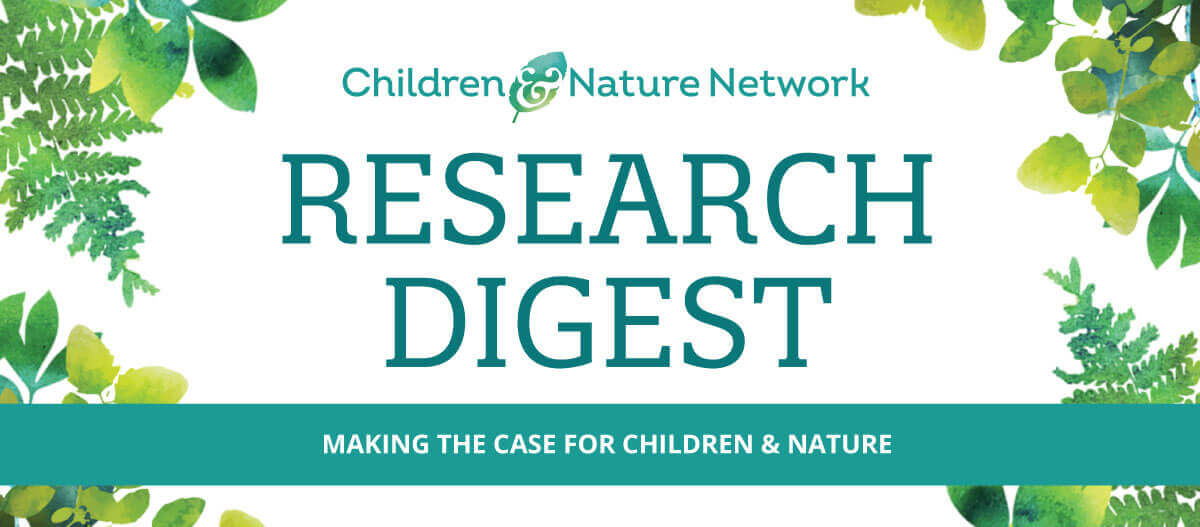The Development of Environmental Activism
Children’s engagement with climate activism encompasses both individual and collective actions. Such efforts can be supported and constrained by institutional and structural forces. Both children and the climate change action movement can benefit when children are actively involved in the process. Factors motivating and/or supporting children as environmental activists are perhaps less understood than factors influencing adults. Potential factors identified through recent research include family, teachers and a personal belief in behaviors having desired outcomes.
Review of the literature calls for further investigations and the development of theories outlining the formation of nature connectedness
This systematic review of the literature aimed to identify key concepts that predict and help explain the development of connectedness to nature and to provide future directions for research. Key concepts identified through the review were categorized into three themes: (1) situational contexts associated with connectedness; (2) individual difference predictors; and (3) internal psychological states. Overall findings highlight the need “for theories delineating the formation of connectedness, a greater focus on process, and increased differentiation between similar antecedents of connectedness.”
Lengieza & Swim, 2021. The paths to connectedness: A review of the antecedents of connectedness to nature.
Access Study
More nuanced studies are needed to understand the link between nature experiences and pro-environmentalism
This review found that, while the literature generally supports a positive association between experiences in nature and pro-environmentalism, some studies report contradictory results. This concern, along with the complexity of related issues, highlight the need for further research. Future studies should include rigorous research designs, use more reliable measures of environmental behaviors, and assess experiences in nature and pro-environmentalism at different time-points over time.
Rosa & Collado, 2019. Experiences in nature and environmental attitudes and behaviors: Setting the ground for future research.
Access Study
Family plays an important role in environmental activism, with parents and children influencing each other
This literature review included 22 papers focusing on adolescents in the context of environmental activism. Findings indicate that concepts and theories from family studies can be applied to the environmental field and that doing so can lead to new ways of solving environmental issues. While targeting adults may be more beneficial in addressing urgent environmental problems, targeting children might be better for long-term issues. In either case, both parents and children are impacted.
Aghayeeabiabeh & Talebi, 2020. Environmentalism in families.
Access Study
Improving access to and contact with nature may promote pro-environmental behaviors
Data from a nationally representative sample of more than 24,000 people (age 16-65) living in England showed that the more individuals visited nature for recreation and the more they appreciated the natural world, the more likely they were to engage in pro-environmental behaviors. The data also showed that urban residents with high neighborhood greenspace tended to engage in more environmentally friendly behaviors than those in low greenspace neighborhoods.
Alcock et al. 2020. Associations between pro-environmental behaviour and neighbourhood nature, nature visit frequency and nature appreciation: Evidence from a nationally representative survey in England.
Access Study
Outcome expectancy is key to understanding the link between childhood exposure to nature and children’s pro-environmental behavior
Outcome expectancy refers to a belief about a behavior leading to a specific outcome. This study found that the link between contact with nature and pro-environmental behaviors was stronger for children with low rather than high outcome expectancy. This unexpected result may suggest that children with a strong belief that their behaviors can be beneficial for the environment may need less nature contact to motivate them to engage in pro-environmental behaviors.
Collado & Evans, 2019. Outcome expectancy: A key factor to understanding childhood exposure to nature and children’s pro-environmental behavior.
Access Study
Appreciative outdoor activities during childhood promote connection to nature and environmental-citizenship behaviors
A study differentiating between types of outdoor activities – appreciative, consumptive, and abusive – allowed researchers to consider the nature of the activity (not just time outdoors) in determining possible connections to pro-environmental attitudes and behaviors. Of these, only appreciative activities – such as hiking and nature photography – were positively linked to children’s connection to nature. Appreciative activities were also positively linked to children’s environmental-citizenship behaviors.
Hoover, 2021. Children in nature: Exploring the relationship between childhood outdoor experience and environmental stewardship.
Access Study
Climate change educators did not identify outdoor experiences during childhood as having a major influence on their environmental work
This study asked 85 adults involved in climate change education and mitigation to identify both significant life experiences and “formative influences” leading to their environmental work. Nature-related experiences – while important influences for some of the respondents – were not a major formative influence for the group as a whole. Social justice concerns were more motivating for action than concerns about the non-human environment.
Howell & Allen, 2019. Significant life experiences, motivations and values of climate change educators.
Access Study
Emotional confrontation may play an important role in addressing environmental problems
A “Nature in Your Face” (NiYF) workshop includes art and eco-visualization activities designed to move people out of their comfort zone and increase the possibility of identifying innovative solutions to community-based problems. NiYF workshops used with 86 students in Norway focused on environmental problems linked to the use of plastics. The participating children experienced eco-anxiety, denial, self-efficacy, and cognitive dissonance. They also identified some practical solutions to the harmful use of plastics.
Löfström, Klöckner, & Nesvold, 2020. Nature in your face – Disruptive climate change communication and eco-visualization as part of a garden-based learning approach involving primary school children and teachers in co-creating the future.
Access Study
Environmental attitude and behavior form around age 7, increase until age 10, level off until age 14, and then decline
This study examined ways in which children’s environmental attitude and behavior unfolded and consolidated from first grade through early adulthood. Assessments completed four different times during the participants’ childhood and adolescent years showed a decline in environmental attitude and behavior from around age 10 until young adulthood. Results also showed that environmental behavior starts to stabilize from age 10 as an enduring trait; whereas, environmental attitude remains in flux from childhood to early adulthood.
Otto et al. 2019. The development of children’s environmental attitude and behavior.
Access Study
Positive childhood experiences with nature can promote continued nature engagement and pro-environmental attitudes in adulthood
Can nature engagement (NE) help college students deal with stress? A study addressing this question found that being outside in nature was exceeded only by talking to friends or family as an avenue for stress relief. Overall results, however, did not support the assumption that college students with more NE would have lower stress levels. Results did show that undergraduates with high NE during their middle childhood years tended to be more engaged with nature and held more pro-environmental attitudes than other study participants.
Sachs et al. 2020. The potential correlation between nature engagement in middle childhood years and college undergraduates’ nature engagement, proenvironmental attitudes, and stress.
Access Study





